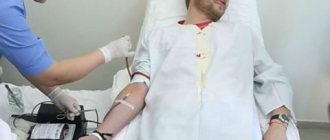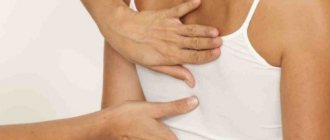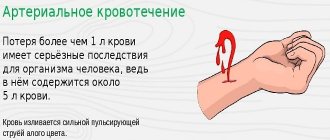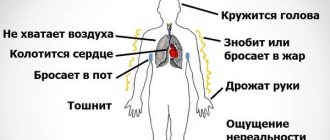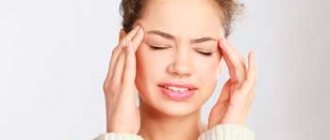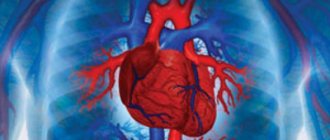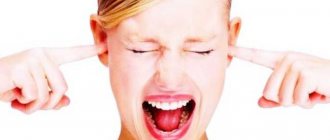More about the symptom
The flow of blood to the face itself can already be considered a symptomatic manifestation of a disease or condition.
There are many reasons for the occurrence of such a condition, and in each specific case, a rush of blood will be accompanied by certain additions.
During a rush of blood, heat may be felt not only in the upper torso, but throughout the entire body, while the internal organs are not affected; the feeling of heat affects only the skin. At the same time, cardiac activity may begin to intensify, and body temperature may rise slightly. Unpleasant for many people can be the appearance of perspiration, sweat, and then a drop in temperature, pale skin, cooling and the appearance of goose bumps.
Typically, such hot flashes occur up to several times a day, and their frequent occurrence up to 20-30 times a day is already considered a pathology. Each attack can last from a few seconds to 5 minutes, in abnormal cases – up to half an hour. They can appear both during the day and at night, during sleep.
It is at night that menopause often occurs in women.
Climax and hot flashes
Women during menopause very often experience a strong feeling of heat, the face turns red, as well as the skin in the neck and chest, and panicked oxygen deficiency also appears, which occurs due to a disruption in the functioning of certain parts of the brain, namely the hypothalamus.
Due to hormonal surges in the body, parts of the hypothalamus receive false signal impulses carrying information about increased body temperature. As a result, the hypothalamus responds with signals about the need to lower the temperature, which leads to increased blood flow towards the head and redness of the skin. That is, the appearance of attacks of a sharp rush of blood in women during menopause.
In order to mitigate these menopausal symptoms, women are most often prescribed estrogen-containing drugs that belong to the group of hormone replacement therapy. Also, during menopause, drugs from the group of antidepressants, herbal medicines with a calming spectrum of action, homeopathic remedies and dietary supplements can be prescribed.
Moreover, for women during menopause, traditional medicine methods such as taking medicinal tinctures and decoctions of medicinal plants can help get rid of hot flashes.
Causes
The number of reasons for the occurrence of a rush of blood is quite large . Among them may be:
- Hyperthyroidism - with increased release of hormones into the blood, the metabolic process accelerates, as a result of which body temperature rises, contractile functions of the heart are stimulated and energy is generated. The flow of blood can be combined with problems with the gastrointestinal tract, a nervous state, and bulging eyes.
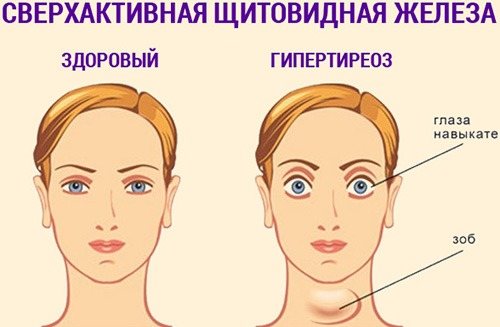
- Cushing's syndrome - the adrenal glands begin to secrete their own hormones in greater quantities than usual. Otherwise, an increase in hormone levels may be a consequence of taking medications based on these hormones. Cortisol helps increase glucose levels, thereby activating metabolism and causing heat and blood flow. Accompanied by obesity, stretch marks, excess hair growth, muscle weakness, and increased blood pressure.
- Hypertension – increased blood pressure is one of the most common causes of blood flow to the face. Vessels and arteries fill with blood, as its release increases when pressure increases. The skin becomes reddish, headaches and dizziness, nausea and vomiting, and a feeling of disorientation occur.
- Hyperthermia – an increase in body temperature occurs with accompanying inflammatory processes. These processes cause the production of IL-1, which provokes hyperthermia to protect the body from infection. May be accompanied by convulsions, rapid breathing, weakness;
- VSD - this type of dystonia provokes an increase in the activation of the parasympathetic system and the vagus nerve, which in turn leads to vasodilation and, as a result, blood flow to the face. In addition, the syndrome is accompanied by profuse sweating and diarrhea.
- Menopause - a fairly common phenomenon of hot flashes develops during menopause in women. The work of the gonads gradually stops, and during this period, estrogens can be released uncontrollably, dilating the blood vessels and leading to sweating and hot flashes. Accompanied by the following symptoms: migraine-like pain, irregularities in the menstrual cycle, sudden mood swings.
- Allergy - this reaction is possible to eating any food, to inhaling dust, pollen, wool and many other allergens. As a reaction to the stimulus, histamines and serotonins are activated and cause vasodilation. Allergies are accompanied by sneezing, coughing, itching, redness of the eyes, runny nose and nasal congestion, skin rashes, and attacks of suffocation.
- Liver diseases - the liver functions like a detoxifier, synthesizes and processes substances entering the body. With liver dysfunction, hepatitis and cirrhosis, many reactions are disrupted, especially the compound of histamine and its breakdown, as a result of which histamine tends to accumulate and dilate blood vessels. Accompanying symptoms may include nausea, gastrointestinal problems, bloating, jaundice, and bitterness in the mouth.
- Poisoning – due to eating a low-quality product or a large amount of alcohol and other harmful substances, blood flow to the face may also develop. Intoxication with alcohol or harmful substances entered into the body with food, as well as poisoning with narcotic poisons, is usually accompanied by vomiting, diarrhea, headaches, fever may rise, and weakness may appear.
- Effect of medications - some medications can cause redness and flushing. This effect can be caused by nicotinic acid, B vitamins, and drugs designed to lower cholesterol and blood pressure levels. These phenomena are natural and may be accompanied by itching, redness of the skin, and watery eyes.
Hot flashes not associated with menopause
The causes of hot flashes in women are not always related to menopause. Such manifestations can occur before menstruation or ovulation, as well as during pregnancy.
Let's look at these situations in more detail.
Signal about the onset of menstruation
Each female body is unique. For some representatives of the fair half of humanity, nature warns about the imminent onset of menstruation or ovulation by a feeling of heat inside the body at a constant temperature. This symptom is temporary. For some, it appears several times during one day, while for others it drags on for several days.
As a rule, hot flashes end on the second or third day of menstruation. After all, the reason for this manifestation is short-term hormonal changes in the body before menstruation, as well as ovulation. After normalization of hormonal balance, the symptom does not appear. Most women go through such days calmly without taking medications.
In some women, hot flashes may be accompanied by pain in the back or lower back, redness of the skin of the face, neck, upper chest, and attacks of nausea. In this case, the woman can consult a doctor in order to select adequate treatment.
As a sign of pregnancy
During the first trimester of pregnancy, changes occur in the woman’s body in the functioning of the cardiovascular system and the thermoregulation center.
Therefore, ladies often experience an increase in body temperature, hot flashes, and profuse sweating. Women after the age of forty are faced with certain menstrual irregularities.
They associate these changes with the early onset of menopause and stop using protection. Since ovulation is still present, there is a chance of getting pregnant. If hot flashes are accompanied by a lack of menstruation, then it is imperative to take a pregnancy test before diagnosing yourself with “early menopause.”
Features of flushing of the face in women

This period may be accompanied by sleep disturbances, anxiety, nervousness, and frequent mood swings.
On top of everything else, fatigue and sweating are added, the latter condition being especially noticeable at night.
Despite the fact that hot flashes in women are a common phenomenon, such a condition should not be left to chance. By consulting with a doctor and undergoing the necessary research, you can help reduce the symptoms characteristic of this period.
Your doctor may prescribe medications to help you cope with the unpleasant symptoms of menopause.
Why does blood rush to the head?
Hot flashes in women associated with age-related hormonal changes are considered physiological. In addition, each of us could experience physiological hot flashes at one time or another in our lives, regardless of gender and age:
- Anger, strong indignation;
- Drinking hot tea or coffee and, of course, alcoholic drinks (it’s not for nothing that they are called strong drinks);
- Staying in a hot room.
Physiological manifestations include hot flashes from eating certain foods, for example, overly spicy and sour foods, food flavored with chili sauce or other seasonings that increase appetite and cause a rush of blood to the head.

Rush of blood to the head, associated with certain circumstances, may not be called physiological, but they are a natural reaction of the body to certain irritants:
- Eating low-quality meat from some fish (tuna, mackerel) also causes hot flashes (taste), which, however, ends as soon as the poisoning products leave the body;
- Food additives and preservatives (calcium sulfite – E226);
- The use of pharmaceuticals: vitamins, nitroglycerin, deworming drugs, calcium antagonists. Meanwhile, they do not always cause particularly strong reactions from the body, which cannot be said about nicotinic acid (vitamin PP, B3) - in the shortest possible time after taking drugs containing it (nikoverin, nikoshpan), they will remind you of themselves with hot flashes to the face , neck and arms;
- People who work with technical solvents and are accustomed to ending their work day with a bottle of beer experience professional hot flashes, although sometimes they themselves are not aware of this connection (the cause of hot flashes in young and healthy men);
- Hot flashes in men also occur when symptoms of androgenization are treated with drugs designed to reduce the concentration of male sex hormones in the blood.
Treatment
The choice of therapy largely depends on the underlying causes of the syndrome.
If the rush of blood is caused by hypertension, especially if this attack is accompanied by vomiting and dizziness, you should consult a doctor. In this case, the specialist may prescribe medications that lower blood pressure, diuretics, calcium antagonists, and beta blockers.
During menopause and its manifestations, women may be prescribed phytoestrogens or hormone replacement therapy.
When an allergy develops, your doctor may prescribe antihistamines, as well as mast cell stabilizers.
Hyperthermia is treated with anti-inflammatory and antipyretic drugs.
If a rush of blood to the face is the cause of heatstroke, the victim should be moved to a cool place, given a drink of water, wiped with cool water and, if necessary, consult a doctor.
The constant occurrence of hot flashes should not be ignored, because they can signal the onset or progression of some dangerous disease that requires treatment. If hot flashes are not a sign of pathology, the doctor will help get rid of the unpleasant symptom and make the patient’s life easier.
Medicines for feeling hot in the body
After conducting a full examination and identifying the cause of hot flashes, the doctor will prescribe appropriate treatment on an individual basis.
Our body is an amazing mechanism, many of whose reactions are still not understood by us. So, every person knows about the functions of blood; this fluid transports nutrients to organs and systems and removes waste products. However, in addition, in some cases, blood can also perform a protective function, maintain the constancy of the internal environment of our body and have mechanical properties. But why can it flow to one or another part of the body? Let's try to figure out what a rush of blood to the face means, what are the reasons for this phenomenon, and whether any treatment is needed in this case.
Causes of flushing of the face
There are several factors that can cause facial redness. But in general, this phenomenon can occur on its own, not accompanied by any other symptoms, or a feeling of heat can be added to it. Facial redness is believed to be caused by involuntary dilation of blood vessels.
In most cases, it is a completely natural reaction of the body to a variety of stresses. This is how the face becomes red in response to high indoor temperatures, as well as due to physical exertion and stress. In addition, redness can be provoked by the consumption of alcoholic beverages or spicy foods.
In some cases, flushing is caused by various hormonal changes occurring in the body. This situation is typical for women carrying a baby, nursing mothers, as well as those representatives of the fair sex who are at the stage of menopause. In all these cases, the body may produce a symptom such as hot flashes. They are accompanied by an increase in blood flow to the facial area, as well as a feeling of heat, followed by chills.
The face also becomes red if a person experiences strong emotions. This could be excitement, sexual arousal, anger or panic. This group also includes embarrassment, which often occurs during adolescence. Such sensations provoke an increase in blood flow speed, which leads to the development of corresponding symptoms.
Redness may also be a reaction of the body to exposure to strong cold winds and frosty weather. In this case, our body tries to correct its internal temperature on its own, so a rush of blood is completely normal.
Another cause of facial redness can be called hypertension. In this case, the patient’s narrowed or clogged blood vessels are unable to ensure adequate blood pumping. Therefore, the heart is forced to work harder, which leads to a rush of blood to the face.
Among other things, there are other factors that explain the redness of the face. This can be severe overheating, for example, with heat stroke, the development of allergic reactions, inflammatory processes, fever and skin ailments. In addition, overweight people often suffer from flushing of the face.
How is the rush of blood to the face corrected, what is the treatment?
If you are constantly faced with significant redness of the skin of the face, which brings you discomfort, you should not ignore this symptom. Be sure to consult a doctor. First, go to your therapist and undergo a general examination. After establishing an accurate diagnosis, a specialist will help you cope with flushing.
In the event that redness is provoked by particularly strong emotions, try to overcome this reaction of the body by working on yourself. So, if you are afraid of public speaking and are blushing, take sedatives and consult a psychologist.
If your body reacts with redness to the consumption of certain foods or drinks, simply remove them from your diet or reduce their amount.
Hypertension requires appropriate treatment under the supervision of a qualified doctor. With such an illness, you need to completely change your rhythm of life, take certain medications and under no circumstances make the disease worse.
The development of heat stroke, one of the symptoms of which is facial flushing, requires an immediate response. So the victim must definitely move to a cool place or at least in the shade, drink water, wash and, if necessary, consult a doctor.
If you suffer from natural facial redness, be sure to use a protective cream before going outside, it will protect your skin from aggressive environmental influences.
Contact a dermatologist, and during the period of therapy, stop using cosmetics containing alcohol. Such substances greatly dry the skin and increase unpleasant symptoms in the form of redness.
Try to change your diet. Avoid spicy foods, coffee and alcoholic drinks. A balanced diet will help you make your face healthy and beautiful, and give your skin a natural color.
Use various cooling compresses based on herbal infusions. Such products optimize blood circulation and cope well with redness.
Try not to damage the epidermis; avoid using hot water, peelings, scrubs and various types of washcloths when washing your face. Also use lightening masks, either factory-made or home-made.
Systematic flushes of blood to the face require careful attention.
Ekaterina, www.site
PS The text uses some forms characteristic of oral speech.
A person’s full life directly depends on the balance of hormones in his body, including sex hormones. The male sex glands produce the main male hormone, testosterone. During puberty, its constant production begins and continues until the extinction of sexual function. With age, the production of this hormone slows down, leading to disruption in the functioning of the autonomic and central nervous systems and endocrine glands. As a result, men experience dyshormonal disorders - climatic neurosis (menopause), in which hot flashes occur.
Symptom danger
Often, such a symptom as blood flow to the face is not pathological and does not pose a particular danger to human life. But in some cases, such a manifestation of the body may be a symptom of a disease.
Failure to see a doctor in a timely manner can trigger an irreversible process of pathology development.
So, for example, hot flashes may mean that a patient has Cushing’s disease , which is dangerous due to its suppression of immunity, bone development and sexual development, its effect on the skin, the patient’s psyche and the development of obesity.
Hot flashes can also mean the presence of an infection in the body, tuberculosis, which must be treated in a timely manner to avoid serious consequences.
Hot flashes can cause the formation of tumors; their early detection will help the patient avoid progression of the disease and prolong life.
Physical exercise
A simple way to quickly activate blood flow in the pelvis is to squat or lift your legs from a lying position. These exercises effectively pump blood to the penis.
To improve the condition of blood vessels and control intimate muscles, you can master the Kegel training technique. The desired area can be easily felt when urination is delayed. Regular exercise will relieve congestion and improve prostate function.
The urologist-andrologist at the Research Institute of Urology named after N.I. talks about the benefits of exercises. N. A. Lopatkina Khizri Zakirovich Khizriev
Further prevention
In addition to the treatment itself and observation by a doctor, you should be more careful and attentive to your body.
Prevention methods include compliance with the following parameters :
- If you suffer from allergies, you should avoid contact with allergens and always carry antihistamines with you.
- In case of menopause, some symptoms can be relieved with special phytoestrogens or traditional medicine.
- As hypertension progresses, you should remember this manifestation of your body and try to monitor your blood pressure and measure it periodically. Don't worry about exposing yourself to physical activity. It is advisable to have medications with you that help reduce blood pressure.
- If hot flashes are caused by the presence of Cushing's disease, the patient should adhere to a special diet, which may include increased consumption of proteins, cottage cheese, milk, eggs, cheese, and also exclude coffee, strong tea, alcohol, fatty foods, and salt.
- In case of hyperthermia, the patient should avoid exposure to direct sunlight and excessive heat; it is advisable to frequently spend time in the fresh air, walk, and install an air conditioning system in the living room. In addition, the patient may need to adhere to a certain diet, water-salt balance, and avoid direct exposure to heat devices: irons, stoves, hair dryers.
- To avoid natural redness on your face, use sunscreen when going outside.
- If any types of food cause redness in the face, you should avoid them. This could be coffee, spicy food, alcohol.
- Cooling compresses can be used to relieve the situation.
- It is worth refraining from washing with excessively hot or cold water, or from mechanical impact on the skin of the face.
- If facial redness is a manifestation of your emotionality, you should take care of mild sedatives that can bring your emotional sphere to a calmer state.
Redness of the skin and a rush of blood to the face is not always a sign of a serious illness.
But even in this case, you should not neglect your health . It is better to once again consult with a specialist and find out the etiology of your attacks in order to know their causes and, possibly, carry out timely treatment.
Hot flashes as a symptom of a serious illness
There are many serious diseases in which hot flashes are one of the characteristic manifestations. Therefore, women who have not yet reached the average age of onset of menopause (45-50 years), or whose age exceeds 60 years, should remember that hot flashes are possible without menopause.
Frequent manifestations of this symptom should alert the lady. This may be associated with the development of a disease or pathology of internal organs. You definitely need to consult a specialist and undergo a medical examination.
In order to diagnose the disease in time and begin treatment. Let's look at what diseases cause hot flashes.
Diabetes mellitus type 2
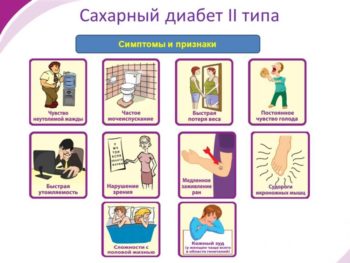
Very often, a woman does not even suspect that she has such a serious disease as diabetes. It develops more often in women suffering from obesity and metabolic syndrome. The symptoms of the disease will be similar to those of menopause. Therefore, very often diabetes is not diagnosed in the early stages.
A woman will have the following symptoms:
- increased sweating, accompanied by an acute feeling of hunger;
- body trembling, which goes away very quickly after eating sweets;
- hot flashes to the upper body;
- redness of the face and neck;
- perspiration appears on the skin;
- disrupted menstrual cycle.
The main difference between the symptoms of diabetes is the feeling of hunger, which quickly passes after taking some sweet product.
The final diagnosis is made after blood tests for sugar levels and insulin levels. Treatment involves: weight loss, switching to a low-carbohydrate diet, physical activity, drug control of blood glucose levels.
Thyroid dysfunction
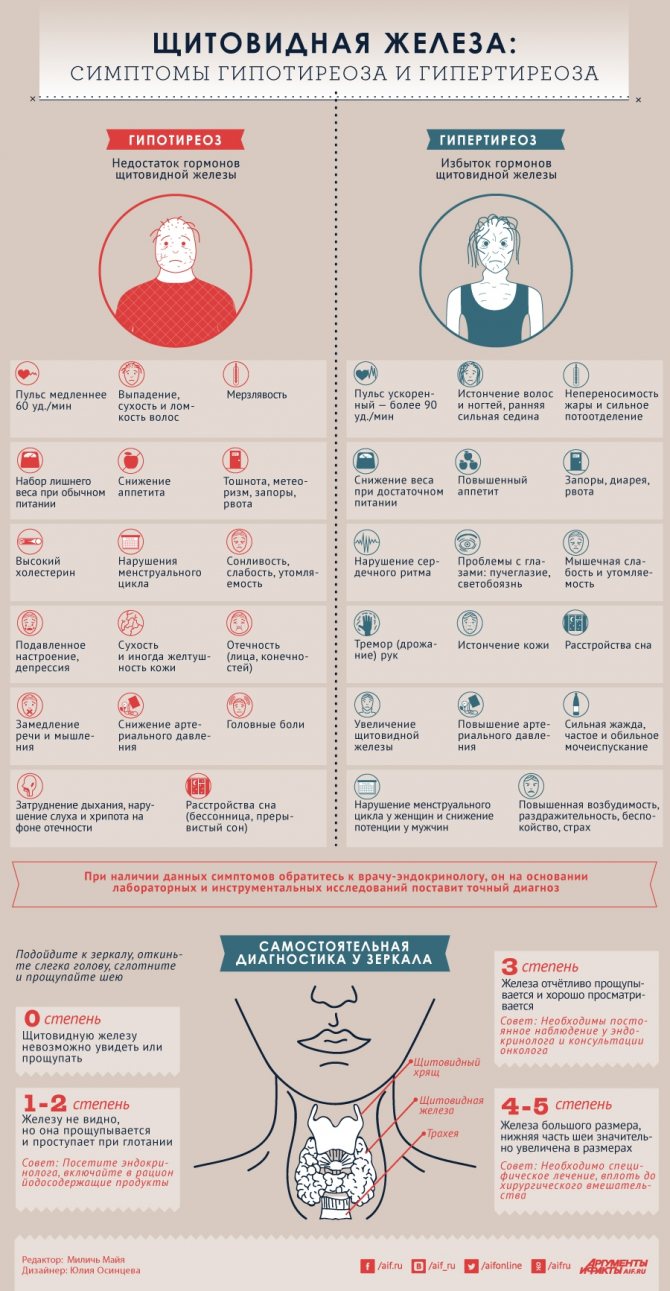
Thyroid hormones influence many processes in the female body. They are involved in the regulation of vascular tone, heat exchange processes, and also have an impact on the menstrual cycle. Therefore, disturbances in the functioning of the thyroid gland have the same symptoms as during menopause: irregular periods, hot flashes, excessive sweating.
There are two main pathologies in the functioning of the organ:
- Hypothyroidism is a decrease in thyroid hormone levels. The main symptoms include: drowsiness, lethargy, lethargy, weight gain with loss of appetite, cycle disruption, swelling, increased sweating. Hot flashes do not occur in all patients.
- Hyperthyroidism – increased function of the thyroid gland. Specific symptoms of the disease are: bulging eyes (protruding eyeballs), accompanied by a painful shine in the eyes and absence of menstruation. In addition, women are worried about: insomnia, increased excitability, heart rhythm disturbances, obvious thinness, hot flashes, increased sweating during sleep.
To establish a diagnosis, a woman must undergo a blood test for thyroid hormones. Depending on their number, the woman will have one or another pathology.
Treatment is carried out either with hormonal drugs or antihormonal drugs. The therapy not only removes unpleasant symptoms, but also normalizes the woman’s menstrual function.
Autonomic nervous system disorders
Previously, the diagnosis of vegetative-vascular dystonia was used, but according to the international classification the name sounds like somatoform dysfunction of the autonomic nervous system. The disease has not yet been fully studied. The patient's relationship between the brain and the peripheral nervous system is disrupted. Often the disease is hereditary.
In a state of stress, fear, or even in a calm state, a woman experiences an attack of palpitations against the background of an increase or decrease in blood pressure. At the same time, the woman feels a rush of heat and redness of her face. In order to make a final diagnosis, it is necessary to exclude menopause. Therefore, the patient takes a blood test for sex hormones.
If the diagnosis is confirmed, treatment is carried out simultaneously by cardiologists and neurologists. It is important for a woman to choose effective sedatives, as well as medications to normalize blood pressure and heart rate. In a woman with an advanced form of the disease, menopause will occur with serious complications.
Hot flashes and men's health
Male menopause is not just hot flashes. A decrease in testosterone production is accompanied by changes in all internal organs and the nervous system. The gradual decline of testicular function leads to the appearance of such concomitant conditions
:
- and interruptions in heart function;
- dysuric phenomena (pain when emptying the bladder, slow urination);
- decreased libido and erectile dysfunction;
- psycho-emotional instability (irritability, fear, tendency to depression);
- weight gain (deposition of fatty tissue in the abdomen, buttocks and thighs)
- general weakness, fatigue.
Such symptoms persist from 2 to 5 years, after which hot flashes and other manifestations of male menopause gradually fade away. As testosterone production decreases, the functioning of the thyroid and pancreas, as well as many other internal organs, is disrupted. With age, the likelihood of developing hypertension, diabetes and other serious diseases increases.
In severe cases of the disease, the doctor may prescribe hormone replacement therapy

